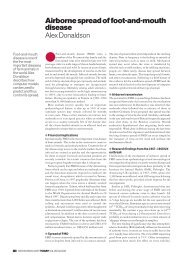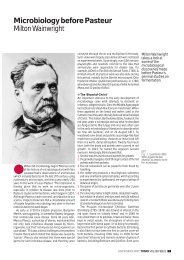Download - Society for General Microbiology
Download - Society for General Microbiology
Download - Society for General Microbiology
Create successful ePaper yourself
Turn your PDF publications into a flip-book with our unique Google optimized e-Paper software.
This year marks the 25th anniversary of three<br />
independent discoveries concerning human infectious<br />
diseases. In 1983, Helicobacter pylori was found<br />
to be associated with stomach ulcers by Robin<br />
Warren and Barry Marshall, human papilloma virus<br />
(HPV) type 16 was identified as a candidate agent of<br />
cervical cancer by Harald zur Hausen’s group, and human<br />
immunodeficiency virus (HIV) was first isolated from a<br />
patient with symptoms suggestive of the early stages of AIDS<br />
by Françoise Barré-Sinoussi, Luc Montagnier and colleagues.<br />
Although these pioneering discoveries were initially greeted<br />
with scepticism, each has stood the test of time.<br />
Gastric ulcer and dyspepsia were never considered to be<br />
caused by an infectious agent be<strong>for</strong>e the discovery of H. pylori<br />
(initially called Campylobacter pylori). While bacteria had<br />
been occasionally observed in the stomach since the early<br />
20th century, this part of the gastrointestinal tract, together<br />
with the small intestine, was generally considered to be<br />
sterile. Neither did the epidemiology of gastric ulcer disease<br />
point towards an infectious agent, although wide variance<br />
in geographic prevalence was noted. H. pylori was later<br />
also shown to be the underlying cause of duodenal ulcers,<br />
stomach cancer and mucosa-associated lymphoid tumours.<br />
Warren and Marshall faced an uphill battle to persuade GI<br />
specialists that the majority of peptic ulcers had a bacterial<br />
aetiology. Barry Marshall resorted to a time-honoured<br />
and dramatic method of testing one of Koch’s postulates on<br />
himself. He swallowed a culture of the bacteria and promptly<br />
developed severe dyspepsia. He also showed that treatment<br />
of ulcer patients with inexpensive antibiotics often cured<br />
the illness altogether. For too long the treatment of ulcers by<br />
antibiotics was strongly opposed by pharmaceutical companies<br />
which sold far more expensive drugs <strong>for</strong> the chronic<br />
treatment of the symptoms, e.g. H2-receptor antagonists.<br />
In contrast to gastric ulcer, cervical carcinoma had long<br />
been thought to result from a sexually transmissible agent.<br />
In 1842, an astute gentleman of Verona, Domenico Rigoni-<br />
Stern, observed that while nuns had an increased incidence<br />
of breast cancer, they seldom developed cervical cancer,<br />
whereas the latter was a frequent disease among prostitutes.<br />
When the hunt was on <strong>for</strong> human cancer viruses following<br />
The SGM<br />
President, Robin<br />
Weiss, recalls the<br />
year in which three<br />
important pathogens<br />
first saw light of day.<br />
c Coloured SEM of Helicobacter pylori<br />
bacteria (pink) on human gastric epithelial<br />
cells (light brown). Science Photo Library<br />
. Coloured TEM of HPV virions. Centre <strong>for</strong><br />
Infections / HPA / Science Photo Library<br />
1983:<br />
a vintage year<br />
<strong>for</strong> pathogen<br />
discovery<br />
the discovery of Epstein–Barr virus in<br />
Burkitt’s lymphoma in 1964, several<br />
investigators implicated herpes simplex<br />
virus type II as the cause, but the<br />
epidemiology was inconclusive. Genital<br />
HPV strains were the first viruses to<br />
be discovered through DNA cloning<br />
because they were not amenable to<br />
classical isolation through cell culture.<br />
Zur Hausen cloned HPV-6 and HPV-<br />
11 in vulval papillomas and used an<br />
HPV-11 probe to pull out HPV-16 and<br />
then HPV-18 from malignant cervical<br />
carcinoma. Cloning methods were<br />
subsequently used to identify many<br />
other non-culturable human viruses,<br />
such as hepatitis C virus, Kaposi’s<br />
sarcoma herpesvirus and this year, a<br />
novel polyoma virus in Merkel cell<br />
carcinoma.<br />
The discovery of genital HPVs led<br />
to the recent development of two<br />
vaccines that prevent infection by the<br />
most prevalent cervical HPV strains.<br />
192 microbiology today nov 08 microbiology today nov 08 193
















